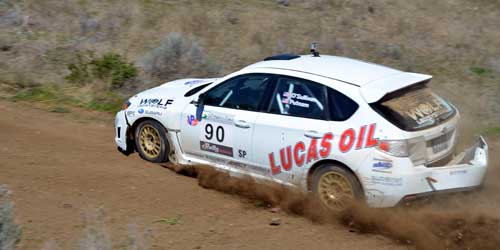By David Gee

It’s all about the Gs baby. No, we’re not talking about the rap song by Big Bang. We’re talking about the measurement of gravitational forces acting on objects such as the human body.
At launch for example, the Space Shuttle astronauts experienced 1.7 Gs.
In a rally car rollover, such as the one Lauchlin O’Sullivan and Scott Putnam endured at the Oregon Trail Rally, they experienced 2 Gs, and for a brief time, exponentially more than that.
There is in fact a mathematical formula to measure this combo platter of G-forces, kinetic energy and violent speed changes the two Rally America competitors and their Subaru were subjected to.
For a scenario where a car stops abruptly from a speed of 30 miles per hour, a slower speed than what O’Sullivan and Putnam were traveling at, the sudden deceleration generates, for a brief moment anyway, as much as 30 Gs and 2.4 tons of force.
Deceleration = 967 ft/s2 = 294 m/s2 = 30 Gs
Force = 4813 lb = 21412 N = 2.4 tons.
And that begs the question; just how many Gs can the human body take, either for short – or extended – periods of time?
Obviously an athlete or astronaut will be able to withstand higher Gs because of their training than the average person.
During practice for the 1977 British Grand Prix at Silverstone, for instance, former British Formula One driver David Purley was briefly exposed to a force estimated at 179.8 Gs after his throttle stuck open in a corner.
In the subsequent impact, his car decelerated from 108 miles per hour to zero in a distance of two feet! He suffered serious leg, hip and pelvic injuries, but recovered to race again.
Even in ordinary grand-prix races, F1 drivers cope with 3 – 5 Gs throughout each race, with the driver’s body experiencing forces 4 1/2 times their own body weight.
But for everyone, their ability to withstand G forces depends on three factors: the direction in which the G forces are felt, the amount of Gs involved, and how long those Gs last.
Though some people have pulled a muscle sneezing (see chart below for different degrees of G), typically we don’t suffer any negative effects from these everyday events because they’re so brief. The trouble begins when G forces linger.
 Photo: Ben Rogge
Photo: Ben Rogge
Though Putnam and O’Sullivan had some lingering issues from their incident, in the form of headaches and soreness, they were lucky to be uninjured for the most part. That is certainly a testament to the safety levels inherent in today’s rally cars.
When Jari-Matti Latvala took his off-course, tumbling-down-the-mountainside excursion in a WRC event a couple of years ago, he and his co-driver Miikka Anttila were also not only uninjured, but many areas of the car’s bodyshell were rebuilt and used in other rallies, just as Putnam’s Subaru is being repaired to rally again this summer.
Some of the credit for that goes to the steel used for the roll-cage construction. It is high in ductility, which means it has the ability to deform under stress.
That allows the roll cage structure to not only absorb sufficient energy to protect the occupants, but also again, it leaves some parts of the car undamaged, despite the horrific forces on it.
In Latvala’s car, basic measurements showed there was no deformation into the cockpit of the main roll cage hoop joint. Also, the A-pillar and door bar roll cage structures remained virtually undamaged on both sides of the car.
Motorsport is all about pushing boundaries, and as a result, it becomes the ultimate proving ground for safety technology. That technology often makes its way into all of our cars, though hopefully we don’t have occasion to generate massive Gs by barrel rolling down the side of the road ala O’Sullivan and Putnam and Latvala and Anttila.
And by the way, next time you take that rolled up car magazine to swat at a fly, consider this. Insects don’t have a circulatory system, so they are masters at enduring G forces because of the mechanical stresses their bodies can absorb. As a result, a fly can happily cope with 200 Gs. Who knew?
Check out the list below for some more of the Gs we humans experience.
DIFFERENT DEGREES OF G
Gravity at sea level: 1g
Ascending elevator: 1.14g
Braking in a sports car: 1.3g
Sneeze: 3g
Cough: 3.5g
Getting jostled in a crowd: 3.6g
Roller coaster: up to 4g
Slap on back: 4.1g
Formula One: 5g
Luge: 5.2g
Jump off a step and land stiff-legged: 8.1g
Aerobatic plane/fighter jet: 9-12g
Car collision with solid object, not wearing a seat belt: 70-100g